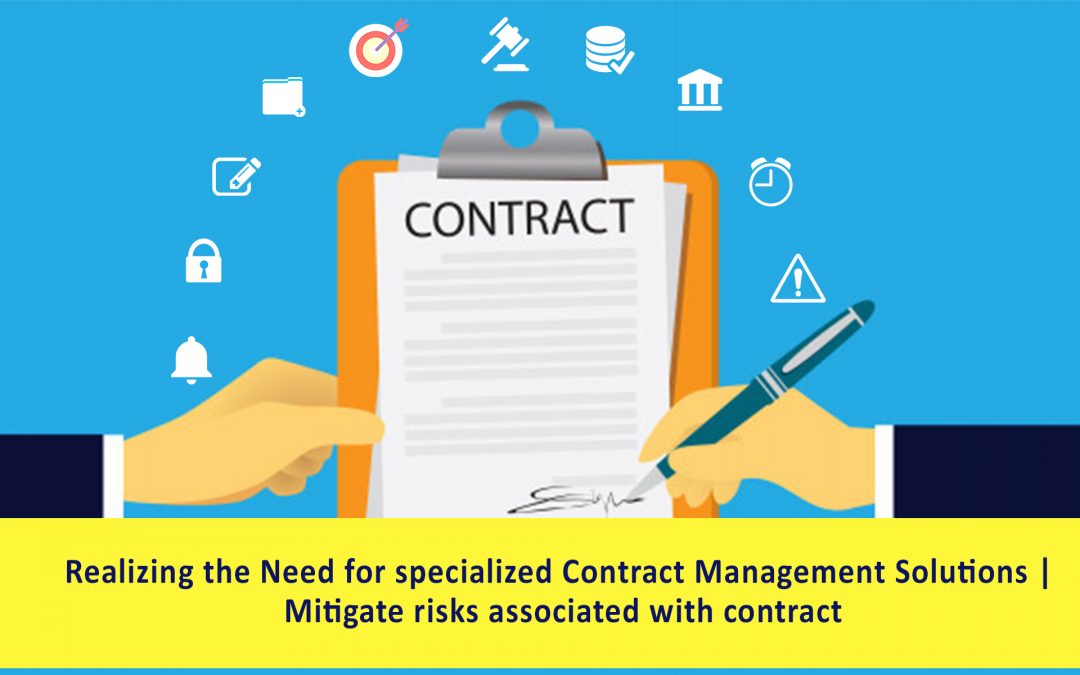All companies need to enter into contracts to transact business. Depending on its size and sector of operations, some companies can have thousands of live contracts at any given point in time. These contracts usually span the entire ecosystem of its business and stakeholders – employees, customers, vendors and suppliers. Moreover, with each contract being unique – having its own set of legal and business nuances; negotiation history; and, associated operational compliances – the entire contract portfolio becomes an area of potential risk for the company.
Regardless of the number of contracts a company may have, where contract management as a process is not given its due priority, in-house lawyers and business teams struggle to keep pace with the drafting, negotiating, archiving and complying with their contract portfolio. Without a defined process, keeping track of documents, contract obligations, milestones and renewals can be a challenge. Given the scope of setting up a contract management process / system, it may seem that maintaining the status quo may probably be the easiest option out. But holding on to incumbent and possibly archaic systems, especially those that don’t take advantage of technology, carries the risk of exposing your organization to the potential landmines that may go off without prior intimation.
An effective contract management system will highlight key data in the pre-signing and post-signing stages, enable its analysis to review trends and in effect identify areas for potential risk. With a system in place, the organization can move from a reactive state to a proactive one and enable in-house teams to take control of the fate of your business and the business relationships that make it possible.
The benefits of having a contract management system are as follows:
- Efficient workflow for drafting, reviewing and finalizing drafts through use of standardized templates, clause libraries and playbook of permitted alternatives;
- Improved contract compliance with defined stakeholders, alerts/reminders, and accountability metrics;
- Improved insights through reports which can enable at-a-glance updates on user performance, counterparty performance, contentious clauses, predictable cashflows, etc.
In this blogpost, we wish to walk you through some of the steps which we believe are essential in setting up a contract management system/process.
Document gathering
Start by collating all executed contracts – from your shelves, shared drives, local hard disks, e-mails, those lying with the consultants and anywhere else. While this may seem to be a herculean task, you may also come across your lost contracts. Now, collate similar such contracts, including associated documents, into separate folders and create a hierarchical structure of your contracts – broken down region-wise, industry-wise, type of contracts etc. and maintain this structure for all future additions.
Standardising templates and clauses
Once all documents are collected in one place, have your team collate similar contracts in one place, identify the critical clauses in each type of contract. Using these, create templates, compile clause libraries, and account for alternatives to each. Store these templates centrally for use in the next instance.
Review and approval workflows
Discuss the strategy for ensuring contract requirements conform to internal quality assurance provisions and address the roles and responsibilities of the individuals involved in this process. Additionally, have designated approvers to ensure drafts and actions are approved quickly with records getting created automatically.
Obligation/renewal tracking
All contracts contain some obligations that require yours and/or the business teams’ attention and action. Further not being aware of expiry/ies and auto-renewals can also be counter-productive. Unless you had already created a contract synopsis, you are required to break down the obligations for all your contracts! You may cringe but there are numerous vendors providing contract management services to create checklists out of contracts.
By adopting the above, your contract processes will be streamlined. You also need to ensure that the critical information in your contracts is protected. Start by creating an elementary access control mechanism. You can also opt for a cloud-based software; but it is always better to have your house in order first. We shall talk about a contract management software in one of our later blogs.
Authors:
- Agnishwar Banerjee, AVP
- Sanjay Das, Manager
Disclaimer:
All material included in this blog is for informational purposes only and does not purport to be or constitute legal or other advice. The Blog should not be used as a substitute for specific legal advice. Professional legal advice should be obtained before taking or refraining from an action as a result of the contents of this blog. We exclude any liability (including without limitation that for negligence or for any damages of any kind) for the content of this blog. The views and opinions expressed in this blog are those of the author/(s) alone and do not necessarily reflect the official position of Lexplosion. We make no representations, warranties or undertakings about any of the information, content or materials provided in this blog (including, without limitation, any as to quality, accuracy, completeness or reliability). All the contents of this blog, including the design, text, graphics, their selection and arrangement, are Copyright 2019, Lexplosion Solutions Private Limited or its licensors.
ALL RIGHTS RESERVED, and all moral rights are asserted and reserved.






Sounds Interesting…
thankyou so much for sharing such useful information. this article has solved the problem of risk and told a way to deal with risk. keep writing.